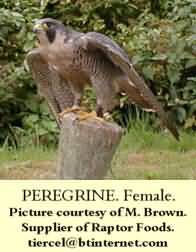
PEREGRINE FALCON. Falco
Peregrinus

‘The Princes Falcon’
IDENTIFICATION. The back is slate grey and the head has the distinct black moustache on white cheeks. The under wing and body has dark barring on white, or occasionally peach, plumage. Juvenile Peregrines have brown/grey plumage with a blue, rather than yellow, cere.
The largest of the common native falcons the Peregrine is difficult to mistake for anything else.
IN FLIGHT. The Peregrine is perhaps best known for its high speed stoop. To gain height the falcon will, with outstretch wings, circle on a hot air thermal, occasionally flapping its wings vigorously to aid lift. When the right height has been achieved (and this can be as much as 1000 feet) the wings are folded tight to the body allowing a high speed and controlled fall to earth. In directed flight the wing beats are powerful and almost pigeon like.
DISTRIBUTION. Becoming increasingly more common throughout Britain, although still often persecuted by those protecting game birds and racing pigeons.
WHEN SEEN. All year round.
FOOD. Birds ranging from blackbirds to pigeons, generally taken in a 150-200mph stoop from a vantage point high in the sky. Unusually for birds of prey Peregrines will sometime hunt in pairs (cast).
BREEDING. Mid April - May. 2 to 6 eggs laid on rock ledge on sea cliffs, quarry rock face or tall building. Young hatch after 29 days incubation, flying just over 1 month later. The juveniles hunting skills may take longer to master and can be seen being trained by the parents for some time after that.
SIZE. 38-48 cm (15-19in)
WEIGHT. 650g-1025g (1lb 7- 2lb 4oz)
CALL. kek-kek-kek
FALCONRY.
Probably the 'ultimate' falcon. Famed for its 150-200mph stoops the Peregrine is revered world wide. Reasonably easy to train, resistant to the 'best' of British weather and inquisitive, the Peregrine can be flown from the fist, from horse back or be allowed to power high into the sky before stooping onto its prey. Quarry varies from corvids to gulls, grouse to pheasant and in days gone by such protected species as Red Kites and Herons.
Female Peregrines are called 'Falcons' and the males Tiercels from the French word for one third. The reason being that most raptors are dimorphic, meaning there is a size different between the sexes. In raptors the females are generally larger and in the case of Peregrines the males are one third smaller, hence Tiercel.
NB. If you buy one of these raptors it should be fitted with a closed leg ring and have an Article 10 form with it (any queries check with DEFRA).
Falconry marks
![]()
![]()
![]()
![]()
![]()